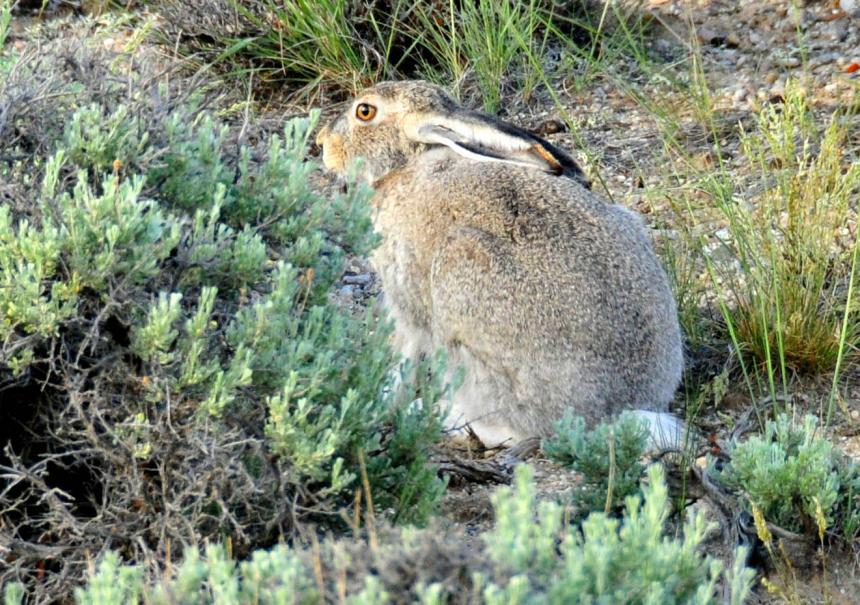Moderate
Once abundant and broadly distributed across the bunchgrass communities of eastern Washington, the white-tailed jackrabbit is now rare and sparsely distributed due to the loss, degradation, and fragmentation of habitat and possibly disease and competition with black-tailed jackrabbits.
Description and Range
Physical description
In Washington, this jackrabbit is grayish-brown; their long ears have black tips and their tail is white. The rabbit is about two feet long and averages about 8 pounds. Females are larger in body size than males.
Ecology and life history
White-tailed jackrabbits prefer hilly, bunchgrass sites. In winter, rabbits descend to sagebrush flats in valley bottoms. They rest by day in shallow holes dug in the ground at the bases of rocks or shrubs, and in winter, they rest in cavities connected by tunnels beneath the snow.
Home ranges may extend 1.2 to 1.9 miles in diameter.
White-tailed jackrabbits are nocturnal herbivores that feed primarily on grasses and forbs and secondarily on shrubs.
Individuals may begin to breed as early as seven months of age. Breeding season begins in late February and may extend into May, with up to four litters produced per year. Nests for young are made of grasses and dry leaves and are hidden in vegetation. The gestation period may last from 30 to 43 days, depending on environmental factors, and the typical litter size is four or five young. Young become independent of maternal care at about two months of age.
Maximum longevity is about eight years.
The species is typically more solitary than other hares.
Geographic range
The white-tailed jackrabbit's range extends from the prairies of the midwestern states and Canadian provinces westward to the Rocky Mountains, Cascades and Sierra Nevada mountain ranges and southward to the northern borders of Arizona and New Mexico.
In Washington, the white-tailed jackrabbit is found throughout the semi-arid portions of the Columbia Plateau. This species was once common across the extensive grasslands of eastern Washington, but with the reduction of bunchgrasses due to overgrazing and encroachment of black-tailed jackrabbits, it is now rare.
For a map of range-wide conservation status and distribution of this species, check out NatureServe Explorer.
Climate vulnerability
Sensitivity to climate change
Moderate
The white-tailed jackrabbit occurs mainly in grassland habitats, with shrub cover sometimes present. In areas in which populations of the white-tailed and black-tailed jackrabbits overlap and may compete, the white-tailed jackrabbit tends to move to higher elevations. Recent modeling suggests that climate change will cause the geographic range of white-tailed jackrabbits to shift northward and decline modestly in overall size. With climate change, warmer temperatures and reduced precipitation are projected to occur in Washington’s Columbia Basin and Okanogan Valley, which will likely lead to more frequent and intense fires. These could negatively affect this species by degrading or eliminating important habitat and causing increases in cheatgrass and other invasive plants with reduced forage value. Drought conditions that alter foraging habitats (e.g., bunchgrasses, rabbitbrush) may also negatively impact this species.
Exposure to climate change
Moderate
- Altered fire regimes
- Increased temperatures
- Reduced precipitation
- Drought
- Increased invasive plants
Conservation
Conservation Threats and Actions Needed
- Fish and wildlife habitat loss or degradation
- Threat: Habitat loss and degradation of shrubsteppe and grasslands due to historic unsustainable grazing practices and invasion of exotic plants.
- Action Needed: Conserve existing and restore degraded shrubsteppe and grassland habitats to provide necessary cover and food resources.
- Threat: Conversion of grasslands and shrubsteppe to cropland.
- Action Needed: Conserve existing and restore degraded shrubsteppe and grassland habitats affected by agriculture to provide necessary cover and food resources. Private landowner incentives such as the U.S. Department of Agriculture - Farm Service Agency Conservation Reserve Program (CRP) may provide benefits to white-tailed jackrabbits, but has not been formally evaluated.
- Population size
- Threat: The species now only occupies a small portion of its historic range in the state and small subpopulations may be susceptible to local extinction.
- Action Needed: Determine potential need and feasibility of reintroductions or augmentations to boost population.
- Disease
- Threat: Disease may have contributed to population declines.
- Action Needed: Assess potential for Tularemia as a factor contributing to population decline. A new threat, Rabbit Hemorrhagic Disease (RHDV2), is a virus that has estimated 90% mortality rate and no cure for jackrabbits.
- Overharvesting of biological resources
- Threat: Control of white-tailed jackrabbits through shooting, poisoning, and trapping may be a contributor to population declines.
- Action Needed: Assess current levels of mortality due to these practices and take steps to minimize lethal control.
See the Climate vulnerability for information about the threats posed by climate change to this species.
Resources
References
Dalquest, W. W. 1948. Mammals of Washington. University of Kansas Publications, Museum of Natural History 2:1- 444.
Lim, B. K. 1987. Lepus townsendii. Mammalian Species 288:1-6.
